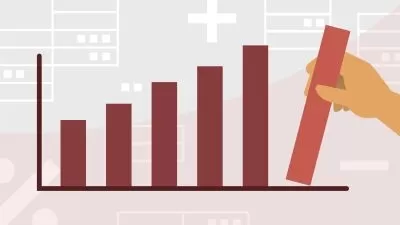Data Analytics 360: Become Data Analyst in Python & Excel
StatElite Academy
20:35:10
Description
Master Python and Excel - 2 Widely Used Tools for A-Z Data Analysis with Complete Foundations and Hands-on Applications.
What You'll Learn?
- You will master the fundamentals of data analytics, including facts and theories, statistical analysis, hypothesis testing, and machine learning.
- You will learn how to apply conditional formatting in Excel to visually highlight key trends, insights, and anomalies within your data.
- You will learn essential Excel formulas and functions such as SUM, AVERAGE, COUNT, IF statements and MORE, enabling you to manipulate data effectively.
- You will learn to utilize Excel's lookup functions (VLOOKUP, HLOOKUP, XLOOKUP) to efficiently search for and retrieve specific information within datasets.
- You will learn various graph and chart types in Excel for data visualization, including bar charts, pie charts, scatter plots, and more to communicate insights.
- You will learn advanced analysis using PivotTables and PivotCharts, enabling you to analyze, and visualize complex datasets with ease and interactivity.
- You will learn to use Excel's built-in data analysis tools for statistical analysis, i.e., descriptive statistics, t-tests, ANOVA, correlation, and regression.
- You will learn to design and create dynamic DASHBOARD in Excel, by a visually interactive format for effective decision-making and reporting.
- You will learn the important Python programming basics such as variables naming, data types, lists, dictionaries, dataframes, sets, loops, functions etc.
- You will master a range of methods and techniques for data cleaning, sorting, filtering, data manipulation, transformation, and data preprocessing in Python.
- You will learn to use Python for data visualizations, exploratory data analysis, statistical analysis, hypothesis testing methods and machine learning models.
- You will work on practical data analysis projects to apply learned skills. Enhance problem-solving abilities through hands-on data analysis exercises.
Who is this for?
What You Need to Know?
More details
DescriptionAre you ready to embark on a journey into the world of data analytics? Welcome to Data Analytics 360, where you'll master two of the most powerful tools in the field: Python and Excel. In this comprehensive course, you'll dive deep into the foundations of data analysis, from basic statistical concepts to advanced machine learning techniques.
Master the Fundamentals: Gain a solid understanding of data analytics principles, including statistical analysis, hypothesis testing, and machine learning. Whether you're new to the field or looking to sharpen your skills, this course provides the perfect starting point.
Excel for Data Analysis: Unlock the full potential of Excel as a data analysis tool. Learn essential formulas and functions, harness the power of conditional formatting to identify trends and anomalies, and utilize lookup functions for efficient data retrieval. Discover the art of data visualization with various chart types and master advanced analysis with PivotTables and PivotCharts.
Python Essentials: Dive into Python programming basics, from variables and data types to loops and functions. Explore methods for data cleaning, sorting, filtering, and manipulation, as well as techniques for exploratory data analysis and hypothesis testing. Harness the power of Python libraries for data visualization and machine learning.
Hands-on Projects: Put your skills to the test with practical data analysis projects. From cleaning and preprocessing data to building machine learning models, you'll tackle real-world challenges and enhance your problem-solving abilities along the way.
Become a Data Analyst: By the end of this course, you'll have the knowledge and skills to excel as a data analyst. Whether you're looking to advance your career or explore new opportunities, Data Analytics 360 equips you with the tools you need to succeed in the world of data.
Enroll now and take the first step towards becoming a proficient data analyst with Data Analytics 360.
Who this course is for:
- Those who are highly interested in learning complete data analytics using Python.
- Individuals aiming to develop comprehensive knowledge in data cleaning, analysis, visualization, and dashboard creation in Excel.
- This course is NOT for those who are interested to learn data science or advanced machine learning application.
Are you ready to embark on a journey into the world of data analytics? Welcome to Data Analytics 360, where you'll master two of the most powerful tools in the field: Python and Excel. In this comprehensive course, you'll dive deep into the foundations of data analysis, from basic statistical concepts to advanced machine learning techniques.
Master the Fundamentals: Gain a solid understanding of data analytics principles, including statistical analysis, hypothesis testing, and machine learning. Whether you're new to the field or looking to sharpen your skills, this course provides the perfect starting point.
Excel for Data Analysis: Unlock the full potential of Excel as a data analysis tool. Learn essential formulas and functions, harness the power of conditional formatting to identify trends and anomalies, and utilize lookup functions for efficient data retrieval. Discover the art of data visualization with various chart types and master advanced analysis with PivotTables and PivotCharts.
Python Essentials: Dive into Python programming basics, from variables and data types to loops and functions. Explore methods for data cleaning, sorting, filtering, and manipulation, as well as techniques for exploratory data analysis and hypothesis testing. Harness the power of Python libraries for data visualization and machine learning.
Hands-on Projects: Put your skills to the test with practical data analysis projects. From cleaning and preprocessing data to building machine learning models, you'll tackle real-world challenges and enhance your problem-solving abilities along the way.
Become a Data Analyst: By the end of this course, you'll have the knowledge and skills to excel as a data analyst. Whether you're looking to advance your career or explore new opportunities, Data Analytics 360 equips you with the tools you need to succeed in the world of data.
Enroll now and take the first step towards becoming a proficient data analyst with Data Analytics 360.
Who this course is for:
- Those who are highly interested in learning complete data analytics using Python.
- Individuals aiming to develop comprehensive knowledge in data cleaning, analysis, visualization, and dashboard creation in Excel.
- This course is NOT for those who are interested to learn data science or advanced machine learning application.
User Reviews
Rating
StatElite Academy
Instructor's Courses
Udemy
View courses Udemy- language english
- Training sessions 154
- duration 20:35:10
- English subtitles has
- Release Date 2024/06/16























